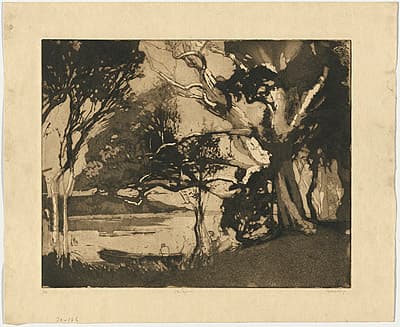
Sydney
LONG
Australia
1871
–
London
1955
England, Europe 1910-21; Australia 1921- 22; England 1922-25; Australia 1925-52; England from 1952
30.1 (h) x 37.6 (w) cm
1/65 , published state , edition of 65 , no manufacturer's mark
Signed lower right below plate-mark in black pencil, 'Sydney Long'. Titled lower centre below plate-mark in black pencil, '.The Lagoon.' Inscribed with edition details lower left below plate-mark in black pencil '1/[illeg.]'.
Reference: Mendelssohn (1979), 83; Paul (1928), 80 National Gallery of Australia, Canberra NGA 1977.9.106 The Stephen Collection, purchased 1976. Reproduced with the kind permission of the Ophthalmic Research Institute of Australia
- J.W.F. Stephen, who formed a definitive collection of the etched work of Sydney Long. J.A.C. Stephen, the artist’s son, by descent. Purchased by the Australian National Gallery, from J.A.C. Stephen, Sydney, 1977.
Possibly Long’s most spirited and adventurous print, this image of trees is a tour de force. The lagoon is, in some respects, a transcription of the oil painting The blue lagoon (cat 66), painted one year earlier. But to say this is to diminish the achievements of the print, because Long did much more than repeat his oil painting in the print medium. He used all his experience and knowledge of printmaking to create a dramatic image in its own right, using a range of carefully balanced darks and lights, and gradations in between. Indeed, while the oil is an exceptionally painterly work, the print is a defiantly printed image – it offers sheer visual delight in its tonal masses and its bitten surfaces.
This print may at first appear to have no precedent in Long’s previous output, and yet the rich use of aquatint, the subtle gradation of tones, can also be found in earlier, less dramatic, but still exceptionally able prints, such as Beddington Corner (cat 82). But in The lagoon, the calm quietude of his earlier prints has been shot through with an electric current.
A copy of The lagoon was first exhibited in 1935 at the ‘Eighth annual exhibition of the Painter–Etchers’ and Graphic Art Society’, Sydney, 8–19 October (90, as ‘The edge of the lagoon’). Copies of the print are held held by the Art Gallery of New South Wales and the Tasmanian Museum and art Gallery.
Possibly Long’s most spirited and adventurous print, this image of trees is a tour de force. The lagoon is, in some respects, a transcription of the oil painting The blue lagoon (cat 66), painted one year earlier. But to say this is to diminish the achievements of the print, because Long did much more than repeat his oil painting in the print medium. He used all his experience and knowledge of printmaking to create a dramatic image in its own right, using a range of carefully balanced darks and lights, and gradations in between. Indeed, while the oil is an exceptionally painterly work, the print is a defiantly printed image – it offers sheer visual delight in its tonal masses and its bitten surfaces.
This print may at first appear to have no precedent in Long’s previous output, and yet the rich use of aquatint, the subtle gradation of tones, can also be found in earlier, less dramatic, but still exceptionally able prints, such as Beddington Corner (cat 82). But in The lagoon, the calm quietude of his earlier prints has been shot through with an electric current.
A copy of The lagoon was first exhibited in 1935 at the ‘Eighth annual exhibition of the Painter–Etchers’ and Graphic Art Society’, Sydney, 8–19 October (90, as ‘The edge of the lagoon’). Copies of the print are held held by the Art Gallery of New South Wales and the Tasmanian Museum and art Gallery.
Possibly Long’s most spirited and adventurous print, this image of trees is a tour de force. The lagoon is, in some respects, a transcription of the oil painting The blue lagoon (cat 66), painted one year earlier. But to say this is to diminish the achievements of the print, because Long did much more than repeat his oil painting in the print medium. He used all his experience and knowledge of printmaking to create a dramatic image in its own right, using a range of carefully balanced darks and lights, and gradations in between. Indeed, while the oil is an exceptionally painterly work, the print is a defiantly printed image – it offers sheer visual delight in its tonal masses and its bitten surfaces.
This print may at first appear to have no precedent in Long’s previous output, and yet the rich use of aquatint, the subtle gradation of tones, can also be found in earlier, less dramatic, but still exceptionally able prints, such as Beddington Corner (cat 82). But in The lagoon, the calm quietude of his earlier prints has been shot through with an electric current.
A copy of The lagoon was first exhibited in 1935 at the ‘Eighth annual exhibition of the Painter–Etchers’ and Graphic Art Society’, Sydney, 8–19 October (90, as ‘The edge of the lagoon’). Copies of the print are held held by the Art Gallery of New South Wales and the Tasmanian Museum and art Gallery.
